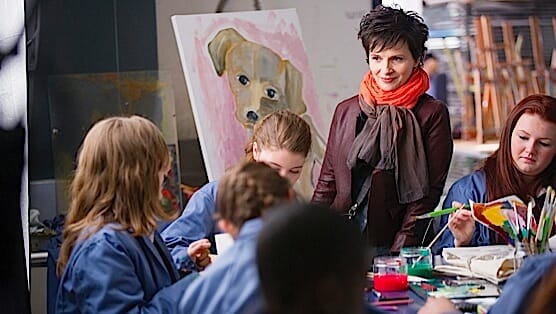
If it takes well into a person’s twenties before fully absorbing the reality that one’s parents are actual people, with their own hopes and dreams, fears and pressure points, that comprehension, oddly enough, typically comes earlier in regards to teachers, when the veneer of stentorian authority is punctured—either by an instructor’s casual jocularity, some flaming screw-up or their serial challenge to previously unchallenged ideas and mores. Words and Pictures, scripted by Gerald Di Pego and directed by Fred Schepisi with an aplomb that belies its hyper-charged emotionality, centers on two such characters.
In doing so, it offers a rich, playful vehicle for Clive Owen and Juliette Binoche to parry and thrust, and maybe even fall in love. Fans of smart adult romantic comedies (this is easily the sort of picture one could imagine Meg Ryan and Billy Crystal starring in together about 20 or 25 years ago) with a pinch of screwball mojo will be rewarded by Words and Pictures, which reminds viewers that life doesn’t end at 40 years of age, or even 50.
The movie unfolds at a tony Maine prep school, where the increasingly problematic behavior of Jack Marcus (Owen), a once-celebrated novelist who teaches English literature and composition, hasn’t gone unnoticed by administrators. Jack is up for an impending review when the arrival of new instructor Dina Delsanto (Juliette Binoche), a prickly abstract painter with rheumatoid arthritis who is every bit his intellectual equal, catches his eye. They mock-argue, but clearly there is considerable mutual respect.
As Jack copes with both writer’s block and a functional alcoholism that exacerbates the disappointment of his adult son, Anthony (Christian Scheider), Dina tries to adjust to an increasing lack of mobility and fine motor coordination, which erode her ability to paint. At the core of their bickering is the comparative value of prose and images. Jack declares a “war” between the two, with a bet involving the school’s literary magazine. The teachers’ impassioned feelings on the subject capture the attention of their students, including some—like Emily (Valerie Tian), Swint (Adam DiMarco) and Cole (Josh Ssettuba)—who are in both classes.
There’s an overall playful vibe to Words and Pictures, even in its scenes of lashing out and self-destruction. If writers creating characters who are writers and artists can in turn incur the risk of a project disappearing up its own ass, Di Pego does a good job of instead tapping into the deeper, elevating elements of both florid prose and high art, of how they can inform and inspire culture and help lift societies out of malaise. If the banter isn’t quite on the level of, say, Moonlighting (another unusual model, in some respects), it does generally pop, enlivened as it is by two game performers. (“Aren’t you attracted to me?” Jack asks. “Not in the least. Did you think I would be?” Dina replies. “Well, I had high hopes for this jacket,” comes the rejoinder.)
Schepisi sidesteps a lot of the clichés of his characters’ afflictions, and keeps things airy but proportionally grounded. Considerable praise is also due production designer Patrizia Von Brandenstein and costume designer Tish Monaghan, who help craft a rich world on a modest budget; the brief spotlighting of Jack’s well-worn shoes in one scene speaks quiet volumes about his character.
At the center of the film’s appeal, though, are its two lead performances and the joy of watching these actors seemingly discover each other in real time. Owen and Binoche sparkle, while never losing grasp of the headstrong qualities that make their characters dedicated and formidable opponents on the philosophical question at the movie’s core: is a picture really worth a thousand words?
It doesn’t spoil much of anything specifically to say that the film’s ending disappoints—yielding to that tired cinematic convention where protagonists insult one another and laugh heartily, to indicate that a détente has been reached. One wishes Di Pego had reached for something more complex; Owen and Binoche deserve better for their efforts. A hearty demerit, too, is earned for a subplot both tone-deaf and unnecessary, in which the cocksure Swint stokes conflict by “teasing” Emily in brutal fashion. It’s severely misplaced, this mean-spirited strand, and suggests either a misguided stab at compare-and-contrast parallelism with Jack and Dina’s relationship or just being completely out-of-touch about the way teenagers interact. Either way, one wishes Di Pego had self-edited with a bit more discipline, and reinvested that time in his complicated, faulty main characters, and a conclusion worthy of their stirred obsessions.
Brent Simon is a regular contributor to Screen Daily, Paste, Playboy and Magill’s Cinema Annual, among other outlets, as well as a member and former three-term president of the Los Angeles Film Critics Association. You can follow him on Twitter and on his blog.
Director: Fred Schepisi
Writer: Gerald Di Pego
Starring: Clive Owen, Juliette Binoche, Adam DiMarco, Valerie Tian, Josh Ssettuba, Christian Scheider, Navid Negahban, Bruce Davison, Amy Brenneman, Janet Kidder
Release Date: May 23, 2014